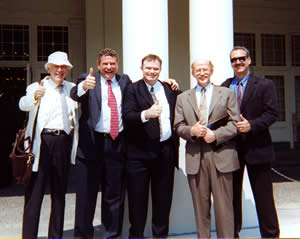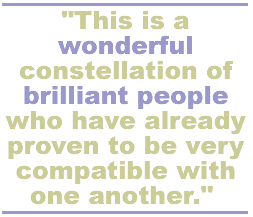
While Waterston served as head of the Department of Genetics at Washington University School of Medicine, as well as director of the school's Genome Sequencing Center, his colleagues started leaving for the West. Olson and Green both came to UW in the early '90s, when then-UW Professor Leroy Hood was organizing the Department of Molecular Biotechnology.
As the century turned, that department and the Department of Genetics merged into a new Department of Genome Sciences. Waterston would have been a dream candidate as its first leader, but he seemed firmly in place in St. Louis.

Bob Waterstson (second from right) celebrates the conclusion of the Human Genome Project on the steps of the White House with (left to right) Jim Watson, Eric Lander, Richard Gibbs and Richard Wilson.
His road to UW partly began with good luck and impulsive conversation. Green was in Washington, D.C., on a scientific trip in the summer of 2001. He went out to dinner with Waterston and other old friends. Waterston did not know about the opening at UW; somebody else asked Green how the search for a chair was going.
"I said we were still looking. I turned to Bob and asked if he was interested. I told him he should apply," Green says. And they left it at that.
"Phil was smiling, but of course, Phil would always smile," Waterston says of the conversation. "But I did not forget what he said." Eventually the UW was able to lure him away and in January he started his new job as genome sciences chair.

Olson feels Waterston is perfect for the role. The new Department of Genome Sciences includes people with expertise in model organisms, data crunching and medical research. Olson notes that Waterston bridges all those groups-for example, his model organism experience includes the worm, he writes computer programs himself, and he's got an M.D.
"This is a wonderful constellation of brilliant people who have already proven to be very compatible with one another," Sulston says.
"You have the nucleus of a powerhouse," Marra says. He refers to Waterston as a legend among younger researchers. This raises a challenge: Could expectations be any higher?
Waterston says he's not intimated. It's a fresh chance to look ahead. "What matters is the work," he says. "We'll proceed the same way we did before-we'll figure out what problems need to be solved tomorrow."
One of Waterston's former colleagues in St. Louis, Mark Johnston, says the consolidation of the UW departments provides a great opportunity. "It will be led by one of the three or four people who you can truly say marshaled in a revolution," says Johnston. "Bob is very driven. Bob sees the direction where biology is going. He wants to change the world-like a lot of us-but unlike a lot of us, Bob is very good at it."
Walter Neary is a media relations officer for the UW Office of Health Sciences and Medical Affairs News and Community Relations and a former business and technology editor for the Olympian.